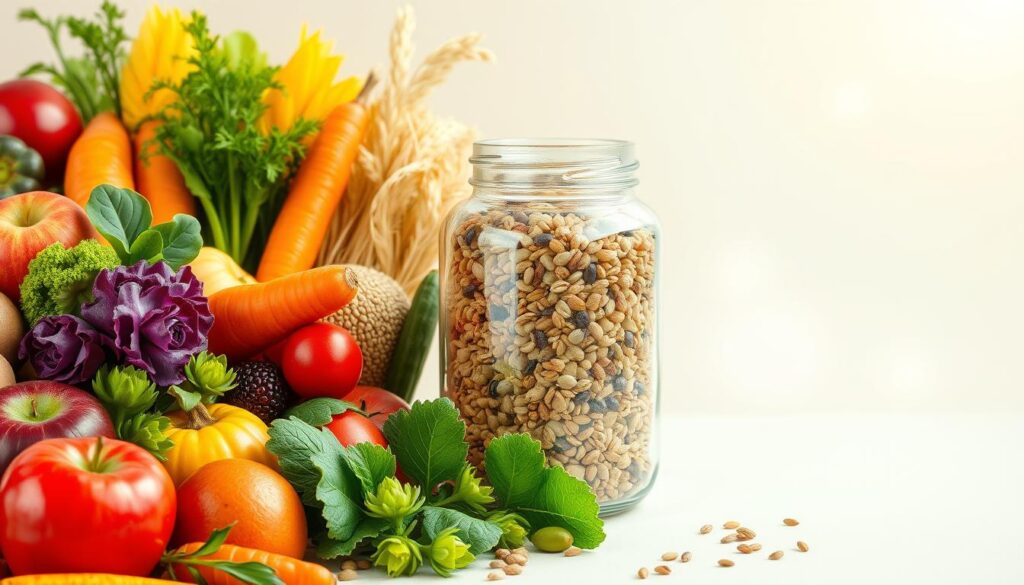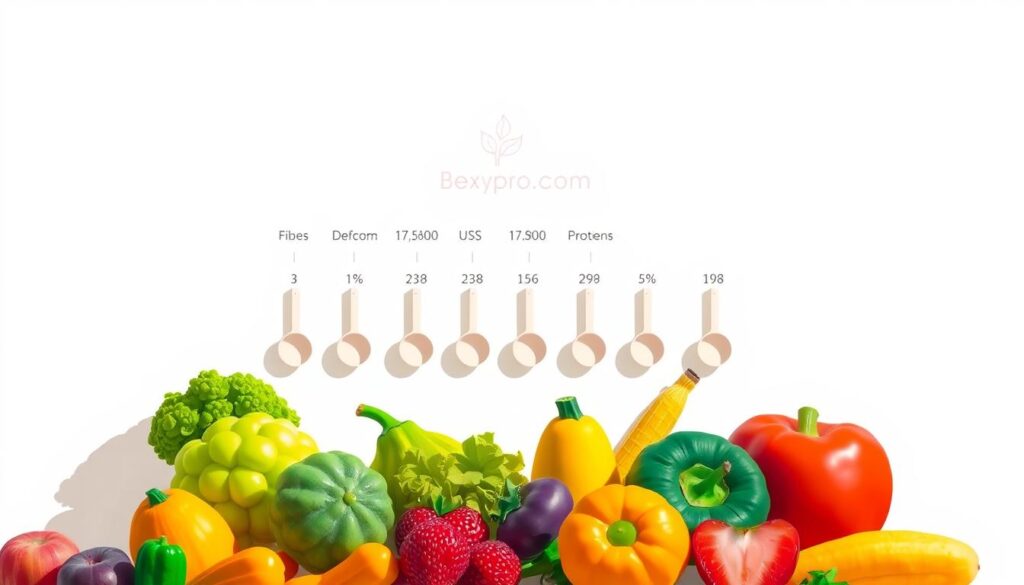Physical Address
304 North Cardinal St.
Dorchester Center, MA 02124
Physical Address
304 North Cardinal St.
Dorchester Center, MA 02124

Surprising fact: U.S. children and adults need 25–35 grams daily, yet most people average about 15 grams — less than half of recommended intake.
Dietary fiber is an indigestible carbohydrate that passes through the gut and helps control appetite and blood sugar. It slows sugar absorption and keeps hunger steadier between meals.
Both soluble and insoluble types offer clear perks. Soluble fiber can lower glucose and cholesterol, while insoluble fiber adds bulk to ease regularity.
Fiber also feeds beneficial gut microbes. Those microbes make short-chain fatty acids, like butyrate, which may reduce inflammation and lower disease risk.
This guide will cover types, how fibers work, health outcomes, daily targets, top foods, and simple strategies to raise intake without overeating. Whole grains, legumes, fruits, vegetables, nuts, and seeds form the best foundation, with supplements like psyllium useful when needed.
Not all fiber acts the same; some dissolve and form gels, others stay intact. Dietary fiber includes nondigestible carbohydrates found in plant foods plus functional fibers added to products for proven benefits.
Soluble fiber dissolves in water and can form a gel. This viscous behavior slows gastric emptying and helps lower blood sugar and cholesterol. Common sources include oats, beans, lentils, apples, and chia.
Insoluble fiber does not dissolve. It adds bulk and speeds transit through the digestive system, which supports regular bowel movements. Think wheat bran, quinoa, leafy greens, and fruit skins.
Some fibers ferment and feed gut microbes, producing short-chain fatty acids that support colon health and may lower disease risk. Others remain nonfermentable and simply increase stool mass.
Think about fiber by function—soluble versus insoluble, viscous versus nonviscous, fermentable versus nonfermentable—to match choices with goals and improve daily intake.
Combining gel-forming and bulky fibers on one plate changes how food affects blood and hunger. This mix supports heart markers while keeping digestion regular.
Soluble fiber (beta-glucans, psyllium) forms viscous gels that slow absorption. That helps steady post-meal blood sugar and lower cholesterol levels.
Insoluble fiber (cellulose, lignin) adds bulk, speeds transit, and eases stool passage. Together they promote comfortable digestion without extra calories.
Fermentable fibers act as prebiotics. Microbes produce acetate, propionate, and butyrate—short-chain fatty acids that nourish colon cells and may reduce inflammation.
“Short-chain fatty acids help maintain colon lining and support overall gut function.”
Viscous soluble fibers from oats, barley, and psyllium help improve cholesterol and lower LDL. Regular intake from whole plant foods links to lower cardiometabolic risk.
| Fiber Type | Main Actions | Food Sources |
|---|---|---|
| Viscous soluble | Slow glucose, lower cholesterol | Oats, barley, psyllium |
| Fermentable | Feeds microbes, yields SCFAs | Beans, inulin, resistant starch |
| Insoluble | Adds bulk, speeds transit | Whole grains, skins, vegetables |
Tip: Track fiber intake briefly to ensure you meet targets and maintain variety for the best long-term health benefits.
How a fiber works — gel-forming, fermentable, or bulky — shapes its health effects.
Soluble fiber forms gels that slow digestion and can bind bile acids. Beta-glucans from oats and barley are highly fermentable and may help normalize blood glucose and lower cholesterol. Psyllium is very viscous, less fermentable, and softens plus bulks stool while also helping blood and cholesterol control.

Insoluble fiber such as cellulose and lignin adds bulk stool and speeds transit. Found in cereal grains, vegetable skins, nuts, and flax, these fibers support regularity and help prevent constipation.
Viscosity means gel-forming power; viscous soluble fibers slow nutrient absorption and change post-meal blood responses.
Fermentability refers to whether microbes can use the fiber. Fermentable types feed gut bacteria and make short-chain fatty acids, but they can cause gas in sensitive people. Gradual increases and plenty of water ease tolerance.
| Type | Main actions | Common sources |
|---|---|---|
| Viscous soluble | Slows absorption; binds bile; may help blood and cholesterol | Oats (beta-glucans), barley, psyllium husk |
| Fermentable | Feeds microbes; yields SCFAs; improves gut ecology | Inulin, FOS (chicory, onions), resistant starch (legumes, cooled potatoes) |
| Insoluble | Adds bulk stool; speeds transit; eases constipation | Whole grains, vegetable skins, nuts, wheat bran |
Practical note: Most plant foods include mixes of soluble insoluble types and deliver phytonutrients too. Rotate oats, beans, fruits, vegetables, and legumes through the week to boost variety and support microbial diversity. Functional fibers like psyllium can fill gaps, but whole foods should be the foundation of intake for long-term health and lower disease risk.
Multiple large studies tie greater fiber consumption to lower cardiovascular risk and mortality. High-fiber diets relate to improvements in cholesterol levels and a lower risk heart disease over time.

Viscous soluble types can reduce LDL cholesterol, helping shift cardiometabolic markers alongside diet and lifestyle changes.
Fiber slows carbohydrate absorption. That effect steadies post-meal blood sugar and helps lower long-term risk of type 2 diabetes.
Higher intake links with a reduced risk colorectal cancer. Fermentable fiber feeds microbes that produce short-chain fatty acids to nourish the gut and colon wall.
Fiber also adds bulk stool, eases transit, and softens stool with sources like psyllium. Whole grains, fruits, vegetables, legumes, nuts, and seeds provide broad protection.
Simple math helps convert calories into a personalized fiber target you can follow every day.

Practical range: aim for 25–35 grams per day for most adults. Another easy benchmark is about 14 grams per 1,000 calories to scale needs with energy use.
Guidance from nutrition authorities puts adult females near 25 g per day and adult males around 38 g per day. After age 50, targets drop to roughly 21 g for women and 30 g for men.
Multiply your typical daily calories by 0.014 to get an individualized goal. For example, a 2,000-calorie day equals about 28 g per day.
Why it matters: hitting targets supports steadier blood sugar and better digestive comfort. Consistency across meals, snacks, and beverages helps you get enough fiber without sudden changes.
Choosing high-fiber foods at every meal makes meeting daily targets simple and sustainable.
Whole grains and cereals deliver steady grams per serving. Oats and barley supply beta-glucans that help blood sugar. Wheat bran, quinoa, and air-popped popcorn are easy swaps for more dietary fiber.
Legumes and pulses are fiber powerhouses. Lentils, chickpeas, black beans, pinto, kidney, and lima offer about 5–9 g per half-cup cooked. Add them to salads, bowls, and soups to raise fiber intake without extra calories.
Fruits and vegetables add fiber plus vitamins and phytochemicals. Berries, pears, and apples with skins give 3–6 g per serving. Leafy greens and sweet potato round out meals and support gut health.
Nuts and seeds supply compact fiber and healthy fats. Almonds, walnuts, chia, and flax boost texture and satiety. Large cohort data show nuts and popcorn do not raise diverticulitis risk and may lower risk.
| Food group | Examples | Fiber per typical serving (g) |
|---|---|---|
| Whole grains | Oats, barley, quinoa, wheat bran, popcorn | 3–6 |
| Legumes | Lentils, chickpeas, black beans, kidney | 5–9 (½ cup cooked) |
| Fruits & vegetables | Berries, pears, apples (skin), leafy greens, sweet potato | 3–6 |
| Nuts & seeds | Almonds, walnuts, chia, flax | 2–4 (small handful or 1 tbsp seeds) |
Meal building tip: aim for one whole grains choice and two vegetables per plate, then add legumes or nuts/seeds. Pairing fiber with protein and healthy fat helps with satiety and steadier blood sugar.
A few targeted changes can boost daily fiber without larger portions.
Simple swaps deliver steady gains: choose whole grains over refined, eat whole fruits rather than juice, and add 1–2 tablespoons of ground flax, chia, or almonds to breakfast. Fold diced vegetables and legumes into soups, stir-fries, and casseroles to raise intake without extra calories.
Food-first plans work for most people, but fiber supplements may help when travel, appetite loss, or tight schedules leave gaps. Psyllium is gel-forming and softens plus bulks stool; it may help cholesterol and glycemic control.
Methylcellulose is nonfermentable and often causes less gas. Both can support regular bowel movements when used alongside fluids and movement.
Increasing intake too fast can cause gas and bloating as gut bacteria adapt. Start with a few grams more every few days, drink plenty of water, and keep daily activity to help the digestive system.
Note that fiber can cause constipation if fluids are low. Choosing gel-forming options like psyllium and pacing increases helps prevent this problem.
| Situation | Best option | Why |
|---|---|---|
| Gap during travel | Psyllium powder or wafers | Bulks stool, portable |
| Gas-prone people | Methylcellulose | Less fermentable, gentler |
| Daily boost from foods | Ground flax, chia, legumes | Nutrition plus fiber |
Practical tip: read labels for total fiber and added sugars, and remember supplements are aids—not replacements—for whole foods and vegetables. Small, consistent steps beat dramatic changes for long-term intake and comfort.
Aim daily plates at whole grains, legumes, vegetables, fruits, nuts, and seeds to capture multiple types that support blood sugar, cholesterol, and gut health.
Target about 25–35 grams per day or roughly 14 g per 1,000 calories. Viscous soluble types like beta-glucans and psyllium can help lower LDL cholesterol and improve cholesterol levels.
Use whole foods first and keep fiber supplements as a backup. Increase intake slowly, drink water, and stay active to reduce common side effects such as gas or cause bloating.
Consistent eating fiber patterns link to lower risk heart disease and lower risk colorectal outcomes over time. Start today with simple swaps and check intake dietary periodically to make progress toward enough fiber for lasting health benefits.